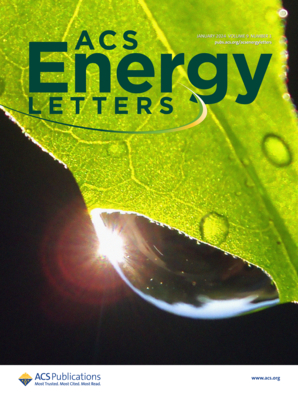Simultaneous Interfacial Modification and Crystallization Regulation for High-Performance Pure-Blue Quasi-2D Perovskite Light-Emitting Diodes
IF 18.2
1区 材料科学
Q1 CHEMISTRY, PHYSICAL
引用次数: 0
Abstract
Quasi-2D perovskites have been recognized as promising candidates for light-emitting diode (PeLEDs) owing to their great optoelectronic properties and solution-processability. However, the disordered initial growth of the perovskites leads to phase disproportionation and defect formation in the perovskite film, which are detrimental to both stability and performance of the pure-blue PeLEDs. Herein, 4-methylbenzenesulfonate (EATsO) is designed as a buried interface to manage the crystallization process of quasi-2D perovskite films. The findings indicate that the strong interaction between EATsO and the precursors facilitates a well-ordered phase arrangement and reduces surface defects in quasi-2D perovskites, thereby enhancing the energy transfer within the perovskite films. Moreover, EATsO tunes the energy level alignment at the interface, which facilitates efficient hole injection and boosts radiative recombination in the PeLEDs. Benefiting from these improvements, the fabricated pure-blue PeLEDs (emitting at 468 nm) achieve a peak external quantum efficiency of 17.4% and a maximum luminance of 2346 cd m–2.高性能纯蓝色准二维钙钛矿发光二极管的同步界面修饰和结晶调控
准二维钙钛矿由于其优异的光电性能和溶液可加工性而被认为是发光二极管(PeLEDs)的有前途的候选者。然而,钙钛矿的无序生长导致了钙钛矿膜的相歧化和缺陷的形成,这对纯蓝发光二极管的稳定性和性能都是不利的。本文设计了4-甲基苯磺酸盐(EATsO)作为埋藏界面来控制准二维钙钛矿薄膜的结晶过程。研究结果表明,EATsO与前驱体之间的强相互作用促进了准二维钙钛矿中有序的相排列,减少了表面缺陷,从而增强了钙钛矿膜内的能量传递。此外,EATsO调节了界面处的能级排列,从而促进了高效的空穴注入,并促进了等离子体的辐射复合。得益于这些改进,制备的纯蓝色pled(发射波长为468 nm)的峰值外量子效率为17.4%,最大亮度为2346 cd m-2。
本文章由计算机程序翻译,如有差异,请以英文原文为准。
求助全文
约1分钟内获得全文
求助全文
来源期刊

ACS Energy Letters
Energy-Renewable Energy, Sustainability and the Environment
CiteScore
31.20
自引率
5.00%
发文量
469
审稿时长
1 months
期刊介绍:
ACS Energy Letters is a monthly journal that publishes papers reporting new scientific advances in energy research. The journal focuses on topics that are of interest to scientists working in the fundamental and applied sciences. Rapid publication is a central criterion for acceptance, and the journal is known for its quick publication times, with an average of 4-6 weeks from submission to web publication in As Soon As Publishable format.
ACS Energy Letters is ranked as the number one journal in the Web of Science Electrochemistry category. It also ranks within the top 10 journals for Physical Chemistry, Energy & Fuels, and Nanoscience & Nanotechnology.
The journal offers several types of articles, including Letters, Energy Express, Perspectives, Reviews, Editorials, Viewpoints and Energy Focus. Additionally, authors have the option to submit videos that summarize or support the information presented in a Perspective or Review article, which can be highlighted on the journal's website. ACS Energy Letters is abstracted and indexed in Chemical Abstracts Service/SciFinder, EBSCO-summon, PubMed, Web of Science, Scopus and Portico.
 求助内容:
求助内容: 应助结果提醒方式:
应助结果提醒方式:


